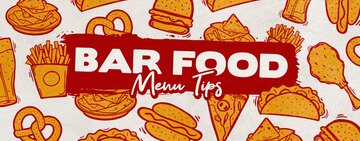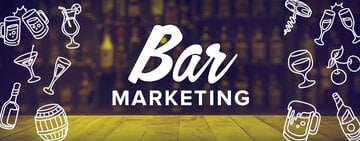One of the most important aspects of opening a bar is creating a marketing plan that will attract new customers. In order to successfully run a bar, you must have several bar promotions to not only reach new customers but also to keep existing customers coming back. Quality bar marketing will have your bar packed with patrons and well-established within the local community. Below, we’ll cover proven bar marketing strategies that will generate awareness for your bar and entice new customers.
You can navigate to the different bar promotional ideas by using the following links:
Bars Social Media Promotions and Online Advertising
Bar Menu Promotions and Diversification
Bar Entertainment
Seasonal Bar Promotions and Calendar Events
Bar Publicity and Partnerships
1. Bars Social Media Promotions and Online Advertising
Most of the population depends on smartphones for communication, browsing, working, and social interactions. What better way to reach your target audience than through mobile devices and online platforms? Social media platforms like Facebook, Twitter, and Instagram are excellent bar marketing outlets that can provide a cost-effective and personal way to reach a large audience in a forum they are already visiting.
Here are a few tactics you can use to reach new customers online and on social media:
Create a Facebook Page
You can create a page on Facebook where customers can interact with photos, polls, and reviews. This allows customers to share their feedback on bar event ideas you come up with. Experiment with posting at different times of day to see which posts your customers interact with the most. You can then find the best time range to advertise bar promotions.
Utilize Facebook Events
Create free online invitations for bar events you’ll be hosting that customers can RSVP to and share with their friends. Mention upcoming beer pong, pool, or poker tournaments on social media with these event pages. This interaction allows you to provide links to online registrations, gauge interest, and provide customers with reminders when the event is coming up.
Use Advertising Hashtags
Display your bar’s hashtag in your dining space to encourage patrons to reference your bar on social media. Offer special promotions like bar discounts for those who use your hashtag and check in at your bar on social media. Turn it into a monthly photo contest by offering a gift card for the best photo that features your bar's name and hashtag.
Work with Brand Advocates and Influencers
Invite local influencers such as bloggers, politicians, and public figures to your location in exchange for a free drink and a bar review. Consider asking loyal customers or employees to act as brand advocates as well and talk about your bar on social media to help boost your bar advertising.
Create a Bar Website
Consider creating a website for your bar and signing up for local directories such as Google My Business, Yelp, and Trip Advisor. A website or listing can help a wider audience locate your establishment. You can use keywords on your website that include the name of your town or city, such as “bars in Manhattan,” to attract customers who are searching for new local places.
Start a Blog and Newsletter
Update your customers on new menu items or give them a behind-the-scenes look at your business by creating a bar blog or email newsletter. Include unique marketing ideas in your blog by adding videos, photos, and interviews to keep your customers engaged and feeling connected to your bar. Post regularly and add a call to action in your posts to bring customers into your bar.
Get Your Bar on the Map
Help locals and tourists find your bar by making sure your establishment shows up on the map. By adding your bar to Google My Business, it will also add your location to Google Maps. You can input your business information directly in the Waze app to have it listed on their map. To add your bar to Apple Maps, just visit the Apple Business Connect website.
Host a Live Stream
You can keep your customers connected with your business by using live video services like Facebook Live, Instagram Live, or Skype sessions. These services allow your customers to chat back and ask questions. During bar closures, bartenders can stream live cocktail-making tutorials and other mixology tips.
2. Bar Menu Promotions and Diversification
One of the main factors that will attract customers to your bar is your cocktail and food menus. For that reason, it’s important to make your bar menu diverse and easily accessible online. Below, we cover a variety of ways you can diversify your menu and amplify your marketing efforts to reach new customers and audiences:
Promote Your Bar Menu Online
Placing your menu online is a great way to reach more customers in your area. Getting your menu indexed by Google will help your bar’s website appear in the first few search results when local customers are looking for a bar near them. You can also sign up for a SinglePlatform account which allows for your menu to be published on a wide range of search engines, review sites, and social media platforms, increasing your bar’s online visibility.
Bar Alcohol Delivery and Take-Out Options
With the availability of third-party delivery services, alcohol delivery has become one of the fastest growing bar trends. By offering cocktail carry-out or delivery options, customers can enjoy your bar's menu from the comfort of their homes. You can even create and sell cocktail kits, featuring all of the ingredients needed for a signature cocktail, so customers can recreate them at their leisure.
Diversify Your Bar Menu
Encourage patrons to stay at your venue by offering an all-inclusive environment with beverages and food. Consider pairing your bar food and drink specials together for additional deals. If customers hear about combined specials, they're more likely to buy both, increasing your overall sales. Keep in mind that venues not previously serving food may need to acquire a license or permit.
Here are some appetizer ideas for bar-side snacking that your customers may enjoy:
Onion Rings
Chicken Wings
Boneless Bites
Potato Wedges
Chips and Dip
French Fries
Bar Specials Ideas
Since these staple foods are available at most bars, you'll need to add some menu variety to gain a competitive advantage against similar businesses. Try these bar specials to stay relevant and fresh!
Daily Specials - Encourage patrons to try new drinks each time they visit.
Happy Hour - Offering discounted drinks within a certain time window is a great way to fill your bar during slower shifts.
Seasonal Specials - Offer event-inspired or seasonal beers and/or mixed drinks.
Mystery Drink - You could occasionally offer a mystery beer or mixed drink. It'll pique your patrons' curiosity and have them guessing the unknown beverage.
Private Sampling Party - Invite your loyal customers to an invite-only sampling for new drafts or signature drinks. Prior to the event, guests will be frequenting your bar in hopes of gaining an exclusive invite. Plus, it rewards loyal customers for their continued business.
Punch Card Challenge - If your bar offers appetizers consider offering a punch card challenge or a loyalty program. For example, after buying nine appetizers, the 10th one is free! This contest encourages patrons to order food while having a drink.
Signature Dish - Offer a signature dish that can’t be found in other bars in your area. You can try being the home of 6-foot-long subs or extra spicy chicken wings. This will give your bar a memorable edge.
3. Bar Entertainment
Successful bars create an inviting environment that keeps patrons coming back for more. Beyond just serving food and drinks, your bar can be the location of social outings with the implementation of bar entertainment ideas such as games, activities, performances, and other bar events.
Bar Games
Adding bar games to your establishment is a great way to increase your customer base and boost sales. Encourage friendly competition by providing yard and game room equipment like darts, pool tables, lawn games, Foosball tables, games of chance, vintage arcade games, pinball machines, or board games. You can even hold tournaments and offer gift card prizes for the winners.
Bar Music
Consider bringing in special entertainment like a DJ or local talent to attract the community's support to your bar. It could be the first time some guests enter your venue, so you'll want to make a good impression. Additionally, many local performers are likely to have a fan base that will come to watch them and simultaneously discover your bar in the process.
Here are some bar ideas for acts and entertainment to add to your lineup:
Local DJs
Bands
Karaoke Nights
Poetry Slams
Open Mic Performances
Comedians
Plays and Theater Performance
Improv Nights
Dance Troupes
Art Galleries
Be sure to obtain the appropriate music licenses before hosting live performances in your establishment.
Bar Activities
Make your bar the go-to stop for group hangouts by hosting a variety of different activities. These are a few popular ideas for bars that can help attract customers to your location:
Trivia Nights
Hosting a trivia night is a fantastic way to attract new customers and create an interactive experience. Teams will compete against each other for prizes, creating a fun environment that all can enjoy. Trivia nights are extremely popular and don’t require a ton of effort to set up, making them an effective way to bring in new customers.
Bar Olympics
If you cater toward a predominately younger crowd, events like Bar Olympics could be a huge success. Bar Olympics contain many well-known drinking games such as flip cup, cornhole, and beer pong. These games don’t cost a lot to organize, and young patrons will surely have a blast.
Classes
Hosting a variety of classes is a great way to establish a connection with your patrons while providing something of value to them. Bartending classes teach young adults a valuable skill, and might even allow you to find your next great bartender. Alternatively, fun events like art and dance classes are a great way to try something unique at your bar and attract new customers.
Audience Specific Events
If you notice your bar hosts a specific type of crowd or caters to a target market, you may want to consider utilizing specific events targeted towards your audience. For example, if your bar frequently hosts college students, then you may want to consider hosting events for young singles or graduation parties for graduating seniors. Alternatively, if you want to position your bar as a family location, you can host several family-friendly days, offering special discounts for children’s meals.
Themed Events
Themed events are a fantastic way to draw a crowd to your bar and create a wonderful atmosphere. Events like Big Game celebrations and watch parties for local sports teams can bring massive crowds to your bar. Other events like decade parties create a unique and memorable atmosphere that customers will enjoy and want to come back for more.
4. Seasonal Bar Promotions and Calendar Events
Along with themed events, you can use the calendar and food holidays to come up with some clever bar promotions and marketing plan ideas. Large, traditional holidays can be hectic and your patrons most likely already have plans. Instead, pick holidays that relate specifically to your customers and business. Consider these unique occasions for your bar:
Beer Can Appreciation Day (Jan. 24) - Continue celebrating the new year by offering discounts on canned beers. Try serving uncommon and locally-brewed beers for beer can-collecting enthusiasts.
National Irish Coffee Day (Jan. 25) - Bring Irish-themed celebrations to your bar by offering special Bailey's drinks in festive Irish coffee mugs.
National Drink Wine Day (Feb. 18) - This day provides the perfect excuse to showcase your wine list for customers who may not be into beers or cocktails.
World Cocktail Day (May 13) - Try out new drink special ideas on World Cocktail Day to test run recipes you’re considering adding to your menu.
St. Patrick's Day (Mar. 17) - Deck out your bar with leprechaun green decorations for St. Patrick's Day parties. You can run Guinness specials, serve specific St. Patrick's Day foods, and add green coloring to specialty drinks.
Cinco de Mayo (May 5) - Take advantage of drinking-related holidays. For Cinco de Mayo, try offering tequila and margarita drink specials, along with deals on guacamole, tacos, and burritos.
National Chocolate Day (Oct. 28) - Offer delicious and unique mixed drinks like chocolate-rimmed cocktails, chocolate martinis, beers, and wines to celebrate this flavorful day.
Oktoberfest (Early Oct.) - This may be a two-week festival occurring in Germany, but that doesn't mean you can't recognize the merriment of beer, food, music, and dancing by hosting an Oktoberfest celebration at your bar.
First Day of the Season - Ring in each new season with a specialty drink and food menu. You can serve refreshing and floral cocktails for spring, add hotdogs and hamburgers to your summer menu, break out pumpkin and apple flavors for the fall, and switch up your bar list to winter beers when the colder months roll around.
Your Bar’s Anniversary - Provide an opportunity for your customers to connect with your business by celebrating the anniversary of your opening and other milestones along the way with discounts and giveaways.
5. Bar Publicity and Partnerships
Hosting a fundraiser or forming a partnership with a local company is an excellent way to give back to your community and increase your visibility. You may choose to:
Host a Charity Night - Offer to give a portion of a specific night’s proceeds to a charity you have chosen. You can even have members of the charity act as waitstaff and bartenders for the evening to further enhance the partnership.
Work with an Animal Shelter - Publicize pets available for adoption outside of your location. You could also work with the shelter to set up a stand and playpen with available animals right outside of your bar doors. The idea can be a win-win situation, attracting customers to your business while providing homes for pets in need.
Host a Business Mixer - Invite local businesses to your bar for a business mixer. This event establishes important connections with other local businesses, creating important network connections. The companies and employees you host can also network with the other businesses present, creating a great situation for all.
Partner with Local Breweries and Wineries - Working with local breweries and wineries in your area allows you to establish valuable connections in the industry. For example, you could run special deals on a brewery's products, giving them a lot of promotion. In the future, you'll likely be rewarded with discounts on that location's supplies or special treatment in the form of early access to new beverages.
For these bar events, consider contacting the local media via press releases or radio advertisements. It may be helpful to even designate one staff member to serve as your public relations coordinator to ensure effective organization and promotion.
Try out a few of these bar promotion ideas that best suit your customer base and see how they end up impacting your bottom line. Simply showing patrons you care about their safety is a great way to build loyalty and can help promote your bar. With a bit of advertising and creativity, your bar will get noticed by new patrons.






